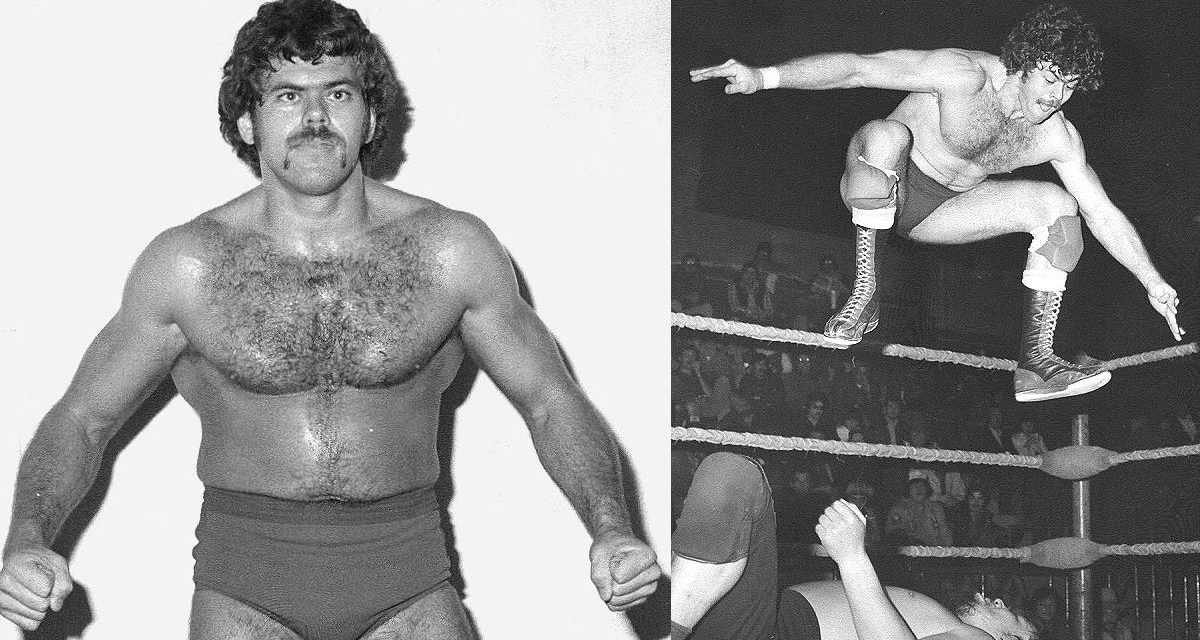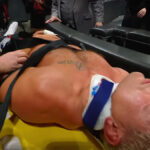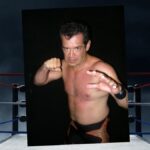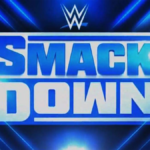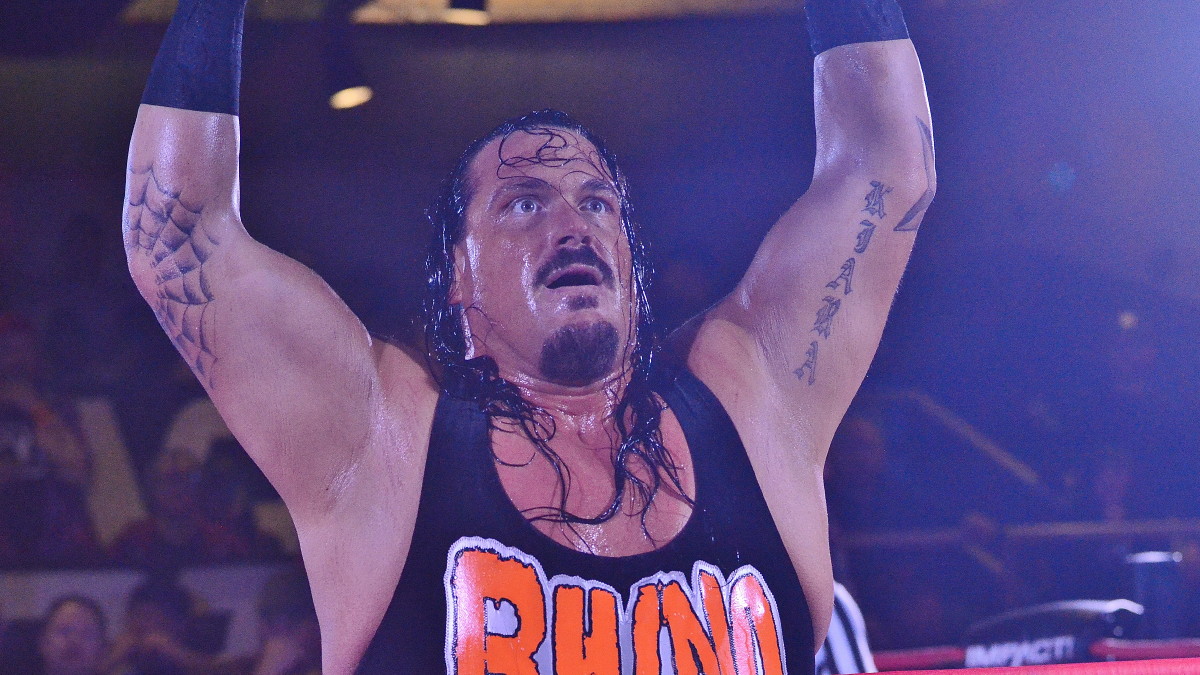BORN: November 12, 1955 in the country near Shediac
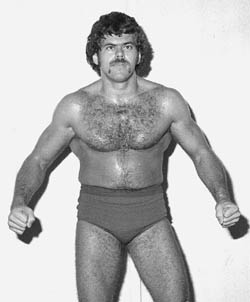
Hubert Gallant All photos by Bob Leonard
5’10”, 220 pounds
AKA: Larry Roberts (first summer); Herb Gallant in Charlotte
A transformation comes over Hubert Gallant as he sings, a deep concentration lines his subtly aged face as he sings songs in French and English from his memory at an impromptu session. It’s obvious that a release of sorts us happening, and that he’s found another way to express himself for an audience, even if it is just a dozen family and friends.
The scene is Roland Cormier’s backyard, in Memramcook, New Brunswick. He’s one of the Cormier brothers that you haven’t heard of. But while his more famous brothers (The Beast, Leo Burke, Rudy Kay & Bobby Kay) are being feted in town in May 2006 [Cormiers celebrated with laughter and music], his home is the place for a few cold beverages, and some impromptu singing on a sunny Sunday afternoon.
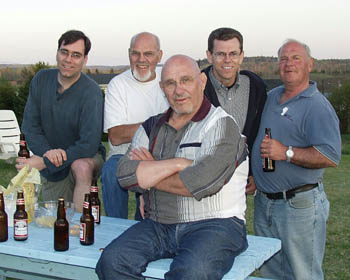
The rogues’ gallery, 2006 — left to right, SLAM! Wrestling’s Greg Oliver, veteran ringmasters Leo Burke and his brother Rudy Kay, Hubert Gallant, and Burke’s and Kay’s non-wrestling brother, Roland Cormier.
Unlike Bobby Kay, who made a post-wrestling career out of music, Gallant just dabbles in it. “The music is my favorite hobby right now. If it wasn’t around, Jesus Christ, I don’t know what I’d do,” he recently told SLAM! Wrestling. Gallant has a bunch of friends he jams with every Wednesday, and plays occasional shows.
He was into country music — particularly Charley Pride — before getting into wrestling, but didn’t play at all. In Calgary, while working for Stu Hart’s Stampede Wrestling, he stayed with Bobby Kay, who showed him a few chords. Before he knew it, those Cormiers had him up on stage. “I knew a couple of songs, so they had me sing. Right from then on, I said, ‘I’ve got to learn this.'”

Hubert’s an accomplished singer and guitarist, and he stepped right up to the bandstand with Francis Cormier and the Bluegrass Diamonds, well-known entertainers around the Maritimes.
When he quit wrestling after 11 years, he bought a guitar, which he keeps in his basement and tries to learn new songs all the time. He may not be a recording star, but he’s okay with that. Just as he’s okay never really having been a main eventer in the squared circle.
“Wrestling was nice too. When you were healthy, young, and you could do it to the best of your abilities, it was a lot of fun. After awhile, when you can’t do it, you don’t enjoy it as much. But with music, you can do that forever, as long as you can keep on talking and singing,” he explained.
Unlike a lot of wrestlers who seem to be stuck in the past, desperately trying to stay involved in the business that was their livelihood for so long, Gallant has comfortably moved on. “When I was in it, I enjoyed it. And when it was over, I just put it behind me. I missed being around the guys, and stuff like that, but I knew I couldn’t do what I was doing before.”
Before he first showed up on Rudy Kay’s doorstep wanting to be a wrestler, Gallant was a machine operator in the woods. After his wrestling career wound down, he bought a machine, and started hauling wood, buying woodlots, and is still doing that today, living with his wife Claire and their two sons.
Growing up in the country near Shediac, NB, Gallant was a hockey player who enjoyed watching wrestling. Like most Maritime boys, his hero was Leo Burke. “Of course, Leo Burke was my idol, right from day one when I went to my first match at the Jean-Louis Lévesque Arena. Him and Pat O’Connor was the match in the main event, and right there, I said, ‘That’s what I want to be,'” he said. “I never gave up my dream, and after I got into the business, I got to know him. I got to be tag team partner with him and everything.”
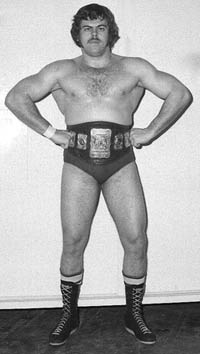
Burke would be more than just a tag team partner for Gallant. He was a mentor, friend, drinking buddy and helped get Hubert booked in Kansas City, Calgary and Charlotte.
But first, Gallant had to get bigger. He was only about 160 pounds when he showed up at Rudy Kay’s door. Instructed to bulk up, Gallant sought out a local weightlifter who had been a Mr. Canada at one time. “I was working out pretty hard at the time, but couldn’t seem to get any bigger,” Gallant said. He was told to do low reps, heavy squats, heavy bench presses, and drink a few protein drinks. “Six months later, I was over 200 pounds.”
By the fall of 1974, he was working out with Emile Dupre, learning how to be a pro wrestler. His debut would come May 2, 1975, when he worked a 15-minute Broadway under the name Larry Roberts.
“Emile knew his stuff. That summer, too, I was fortunate to work with the Cuban Assassin (Angel Acevedo) pretty well three, four times a week. That was a good way to learn too. You couldn’t ask for a better guy to work with,” said Gallant.
That first summer around the Maritimes for Dupre’s Grand Prix promotion was a great start, and he moved on to the other Maritime tour, International Wrestling, later in the year for a few weeks. A stint in Montreal, and more for International Wrestling took up early 1976, and then he was off to Kansas City before coming home again. In the fall of 1976, he made his first trip to Jim Crockett Promotions in North Carolina, working as Herb Gallant. “I wasn’t a top guy. I was just there, especially on TV, doing jobs and stuff. On the house shows, sometimes they put you over.”
In the summer of 1977, he was in Calgary, and that’s where it really all started coming together for Gallant. “Stu Hart really liked me. He liked me the first time he saw me, because I was his type of guy. I was working hard every night. He was telling Leo and them and everybody that he’d never seen me have a bad match. That’s what I was known for, even if they put me over or not put me over, I wouldn’t have a bad match.”
“Hubert was all plus and no minus in Stampede Wrestling,” said former Stampede promoter and photographer Bob Leonard. “He was in for a good part of every year from 1977 to 1985, and he was unfailingly one of the strong talents of the backbone of Stampede — the supporting card that led to that big main event.”
At the time, Bret Hart was a referee for the promotion. Gallant recalled Bret telling him, “If I’m going to be a wrestler, I want to be a wrestler like you.” It makes Gallant chuckle. “That was quite the compliment. He went beyond me.”
In 1978, he was back in Charlotte for half a year. It was there that he had the one singles match that stands out from his career, in Richmond, Va., against Rudy Kay. “Rudy and I went 30 minutes. It’s not to brag or anything, but after the match, Ric Flair and Ricky Steamboat were wrestling after us in the main event. We were the third or fourth match, and we went 30 minutes. [Steamboat] came to me after that in the dressing room, and he said, ‘We can’t follow that.’ That was something, not because of me, but Rudy, he was a worker. He could go.”
Moose Morowski worked with Gallant in Calgary and Charlotte. “He was a good worker. He had a nice body,” recalled Morowski. “He had a very good attitude, and was a nice guy.”
That winter in Calgary and subsequent return to the Maritimes in the summer set the pattern for the rest of his career. He turned down trips to Japan and Germany because he felt that he was doing fine in Calgary.
It was an easy decision to return home each summer. “You always looked forward to come back in the summer to work, even if we were more busy here. Sometimes we worked eight matches in one week, two times on Sunday and every night. But time went by so quick. Summer? You just didn’t see it. But at the time, Emile was doing great business. He had two towns a night running,” he said. “They always had good workers around here. They always had good guys.”
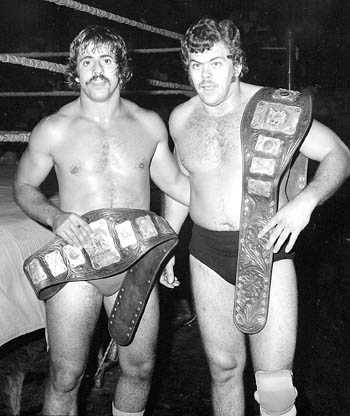
Hubert Gallant and his championship tag team partner Keith Hart.
In Stampede, he got a chance to be a tag champion with Keith Hart as a babyface, and as “Handsome” Hubert, he won tag gold with Danny Davis. Gallant wasn’t one to rock the boat, and was accepting of booking decisions. “I wasn’t fighting for a spot, because I had a guarantee. I wasn’t going to make more money anyway. I would classify myself as a good support on the card, not the guy who could be the main event every night, but someone who was always a good support on a wrestling show.”
The popularity of the Stampede TV show still awes him, especially in relation to its stint into the Caribbean. “We couldn’t go out. They knew us everywhere,” he recalled about a three-day tour of Antigua and Guadeloupe, where he made a whopping $3,300 that week.
Working with Keith Hart also stands out. “I had real good matches with Keith Hart. He would tell you the same too. I enjoyed working with him. He was solid. He never took shortcuts. He was working hard, which is why I enjoyed without with him.”

Gallant sends a youthful Bret Hart over with a backdrop, left, and has an armbar on The Cuban Assassin.
Gallant often teamed with Leo Burke against Bret Hart and The Dynamite Kid, and he figured they probably worked seven or eight weeks in a row. “We sold out the Pavilion. We had heat like you couldn’t believe.”
Duke Myers was one of those evil heels lining up against Gallant in Stampede. “He was a damn good worker; a little light, but he was good,” said Myers. “I worked with him in a couple of places, and we tore the house down.”
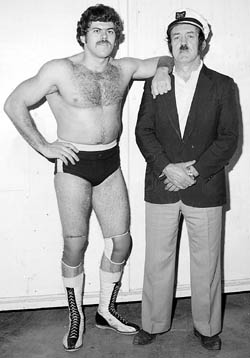
Gallant and J.R. Foley
For the first couple of years of his career, Gallant was a babyface everywhere. Then he had the distinct pleasure of being a face at home in the Maritimes, and a heel under the management of J.R. Foley in Stampede.
Just like anyone who spent any time around Foley, Gallant has a story to tell. They were in Saskatoon and had to go to Regina.
“‘Hubert, why should we go tonight, when we can go tomorrow, and take the bus?'” recalled Gallant. “He wanted to stay there and drink, right? If somebody would buy him a drink, he would take it, of course. When it came time to buy a ticket for the bus, he wanted to buy a senior citizen ticket, because it would be cheaper. He’d gotten drunk the night before, and had been drinking the whole day. We got to the tickets, and he said, ‘As-s-s-k one for me for a senior citizen.’ I said, ‘Give me one, and one for a senior.’ She said, ‘Do you have any proof?’ John was half-drunk, and he looked older than he was. I said, ‘Well, just look at him.’ He glared at me!”
Partying was not big for Gallant, though he enjoyed socializing. “I couldn’t have done it if I had been partying every night,” he said. “I didn’t have the health to do that. I had to rest and get ready for the next match.” That afternoon in Memramcook, though, Leo Burke told a wonderful story about his buddy. It seems that Gallant wanted to show Burke a good time for his 30th birthday. Gallant made plans to take his friend out and get him really drunk in Saskatoon. The night ended with Leo and Bobby Kay carrying Gallant to his room.
Gallant just smiles at the memory. He has lots of them, and he treasures them. Even now, the story doesn’t get his goat. “I wasn’t the type of guy that they could rib and keep on ribbing me, because it didn’t bother me.”
“I did his ring introduction several hundred times around the Stampede territory, and we always had fun with it when he was heeling,” said Leonard. “After his hometown and weight, I’d start his name but I never got beyond ‘Hub….’ No matter if he was just standing in his corner, or baiting the ringsiders, he’d instantly turn and raise an admonishing finger, put on a stern look, and growl ‘Handsome Hubert.’ I’d then apologize, of course, and do the intro again to his satisfaction. Hubert got used to that little schtick, so every now and then I’d trip him up by intro’ing him right off the bat as ‘Handsome’ — and he’d have the finger up and his mouth in action anyway. It broke us both up a few times.”
Hubert Gallant is very content with his legacy in the ring. “When the fans saw me coming in, they knew they were going to see something. They knew they were going to get action.”
Back surgery in 1984 forced him to reconsider his career, as did the birth of his first son. “I stayed off for six months. I tried to make a comeback. I did make a comeback, but it wasn’t the same. I couldn’t dropkick like I used to, I couldn’t do the moves like I used to. I just decided to pack it in.” But it wasn’t a true retirement. For the next few summers, Dupre would call and offer him a few weeks of work on the circuit. “It was just like a vacation. It wasn’t anything big.”
In all, Gallant believes it fortunate the way things worked out. “I think I did well while I was in it, but I don’t think I would have done as good after,” he said. “For the 11 years that I did it, I don’t have any regrets”
RELATED LINKS
